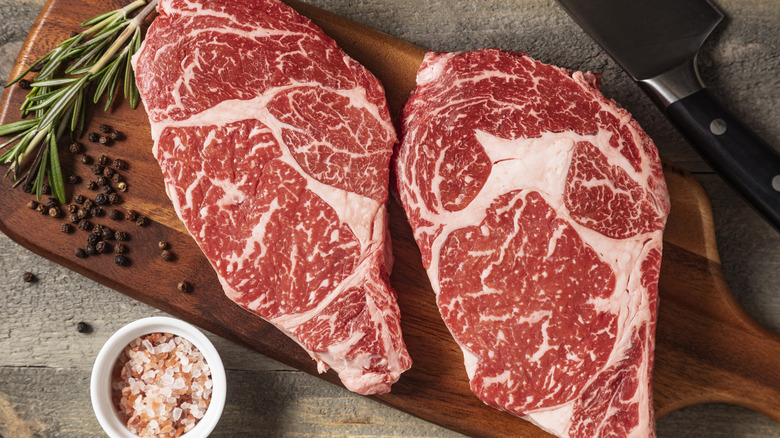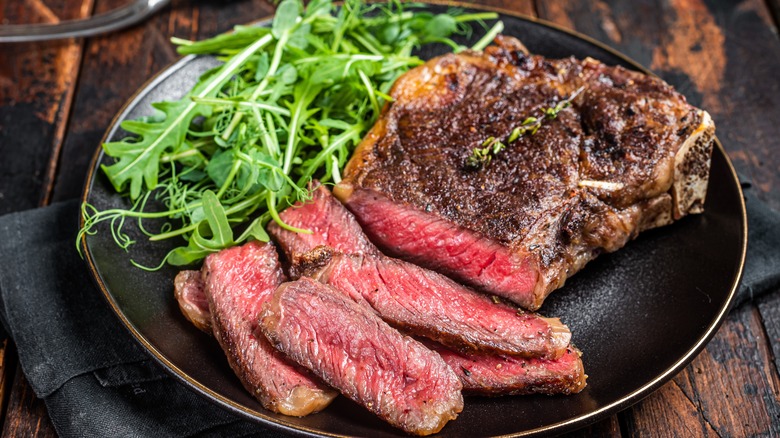The Luxurious California Steakhouse That Serves 3 Different Types Of Wagyu
Wagyu is often regarded as the crème de la crème of steaks, a name synonymous with luxury and masterful craftsmanship. Celebrated as one of the most expensive cuts of meat in the world, its finest examples are distinguished by intense marbling, a melt-in-your-mouth tenderness, and a buttery flavor that delivers a truly indulgent culinary experience that leads many to believe that the steak is worth its high price tag. In much of the Western world, strict import regulations, limited supply, and the meticulous care required to produce authentic Wagyu mean it's a delicacy, one reserved for the menus of the most prestigious steakhouses. One such destination is Niku Steakhouse in San Francisco, an establishment that offers guests a rare opportunity to choose between three exceptional varieties of Wagyu: Japanese, Australian, and Domestic.
At Niku Steakhouse, Wagyu doesn't come cheap. The Japanese Wagyu ranges from $140 to $300 for individual cuts like A3 Mother, A4 Satsuma, and A5 Bushu-gyu. The Australian Wagyu ranges from $75 for the Flat Iron to $275 for the Westholme Wagyu Tomahawk, and Domestic Wagyu is represented by the 44 Farms Ribeye at $125. If you're confused about the lettering for the Japanese Wagyu, it is simply a grading system designed to indicate both the quality and the marbling of the meat. Each cut is given a letter (A, B, or C), referring to the yield, and a number (one to five) that reflects quality, with five being the most luxurious. So A5 is the pinnacle of Japanese Wagyu beef, whereas A3 is still excellent but slightly less marbled and textured, which is reflected in the price difference.
What is the difference between Japanese, American, and Australian Wagyu?
Wagyu refers to a specific breed of Japanese cattle, whose meat is renowned for its exceptional qualities. While Wagyu originated in Japan, exports of live cattle and genetics to the U.S. in the 1970s and Australia in the 1980s have led to the development of Wagyu herds overseas. However, the product varies significantly between regions due to differences in breeding, feeding, and grading.
Japanese Wagyu is widely regarded as the gold standard. Abiding by strict regulations, producers follow centuries-old rearing and feeding traditions. Every cow's lineage can be traced back at least three generations to guarantee purity and authenticity. The purest, top-quality Japanese Wagyu features intense marbling, rich flavors, and a melt-in-your-mouth texture that commands premium prices worldwide. Australian Wagyu follows less strict rules. While Australian Fullblood Wagyu maintains 100% Wagyu genetics, crossbreeding with other cattle, such as Angus, is common. These crossbreeds yield more affordable meat that still offers rich marbling and buttery texture. Australian Wagyu can be grain-fed in the traditional method, but it is also commonly grass-fed. It's generally considered a step below the very best Japanese beef in terms of purity and grading consistency.
In the U.S., Wagyu is becoming increasingly accessible outside of high-end restaurants. Only about 5,000 animals in the U.S. are Fullblood Wagyu. The Japanese genetics range from 37.5% to 87.5% in common types of American Wagyu (i.e., Percentage and Recorded Wagyu). The meat has moderate marbling compared to Japanese and Australian Wagyu but is often at a more affordable price point.


